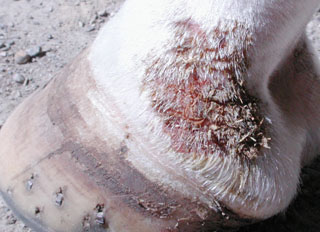Scratches is a problem in the heels and back pastern regions in horses. It is
often caused by the bacteria Dermatophilus congolensis (see rain scald
E770) and Staphylococcus spp. Sometimes, fungal organisms (dermatophytosis)
are also involved. This problem occurs most commonly in horses that are
kept in muddy, wet environments. It seems to be more common in horses with white
socks or pasterns. Other problems such as photosensitization (see E835)
and grazing on abrasive pasture may increase the chances of developing the
disease.
Clinical Signs: The skin in the heel region on one or all four feet, most
commonly the hind, are inflamed (dermatitis) and swollen. The area produces a grayish
discharge that often feels "greasy" to the touch. The area may
lose the hair and the skin can crack and become infected. In severe cases, the
inflammation may cause lameness.

Disease Transmission: The organisms that cause this problem are found in
wet, muddy environments. The horse contacts these organisms when it is forced
to stand in these environments. If a small wound or injury occurs in the skin
(sometimes the result of photosensitization, allergies, irritants, and other
organisms), the bacteria and fungi readily infect the wound.
Diagnosis/Treatment: Diagnosing this problem is often based on appearance
and history. Cultures for bacteria and fungi can also be performed. Most mild
cases of scratches can be treated with antibiotics, antifungals, and topical
anti-inflammatory products such as Panolog (nystatin/neomycin/polymyxin/hydrocortisone)
or Neo-Predef (neomycin sulfate/isoflupredone acetate/tetracaine HCL). Before
these products are applied, the hair over the affected areas should be clipped
and the skin thoroughly cleaned (sometimes scrubbed) with soapy water, dilute
betadine, or chlorhexidine. Rinse the area, let it completely dry and then apply
the ointments twice a day for 7 days. Keep the involved areas dry and remove
the horse from the damp environment.
Prevention: Keep all horses from spending excessive amounts of time in
wet, muddy environments. Horses with white socks and pasterns may benefit from
having sunscreen applied to the back of the heels and pasterns on a daily basis.
This condition, however, tends to persist in some horses and recurs often.
